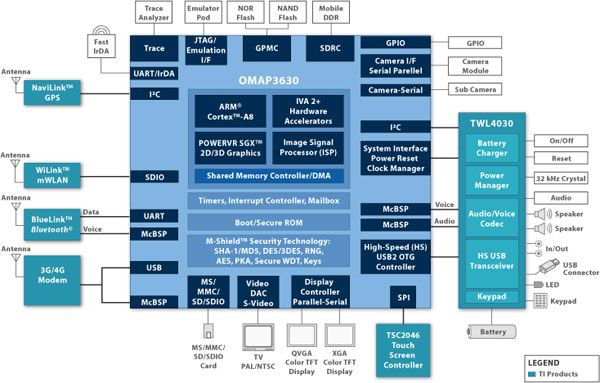

Texas Instruments’ move from the OMAP 3430, used in phones like the Palm Pre, to the OMAP 3630 used in the Droid X is reminiscent of this sort of steady progress I mentioned above.
The OMAP 3430 was built on a 65nm process (like Qualcomm's Snapdragon), while the 3630 is a 45nm shrink (like Apple's A4). Architecturally the two SoCs are very similar. They both use a standard ARM Cortex A8 CPU paired with an Imagination Technologies PowerVR SGX 530 GPU. The two SoCs fit in the same size package (12mm x 12mm BGA) and are ball compatible. If a customer wanted to, it could simply drop in a 3630 into an existing 3430 design with minimal engineering efforts.
Note that the most direct competitor to the 3630 is Qualcomm’s Snapdragon. While TI uses a standard Cortex A8 core from ARM, Qualcomm designed its own low power ARMv7 based core that is similar, but not identical to the Cortex A8. Both are dual-issue, in-order architectures - they’re like the original Pentium, but in your phone. Qualcomm also integrated the cellular modem into the Snapdragon SoC while TI’s OMAP 3 is a strict application processor - the modem is housed in a separate chip.

On the CPU side TI doubled the L1 cache of the 3430 to 64KB (32KB instruction, 32KB data). The L2 cache remains unchanged at 256KB. We won’t get a larger L2 until the OMAP 4, which will ship with a 1MB L2 shared among its two cores. There are the usual tweaks and bug fixes which may improve performance per clock a little bit over the 3430, but overall the 3630 just gets a larger L1 as a result of the die shrink - oh and a much higher clock speed.
The Cortex A8 now runs at up to 1GHz. The OMAP 3430 topped out at 800MHz in shipping configurations but most vendors ran it at sub-600MHz speeds to save power. The 3630 in the Droid X runs at a full 1GHz. It's worth pointing out that Qualcomm was able to hit 1GHz on a similar architecture at 65nm by designing its core from the ground up. There's clearly value in these custom designs from a performance and time to market standpoint. These advantages will only become more critical as the SoC performance wars heat up.